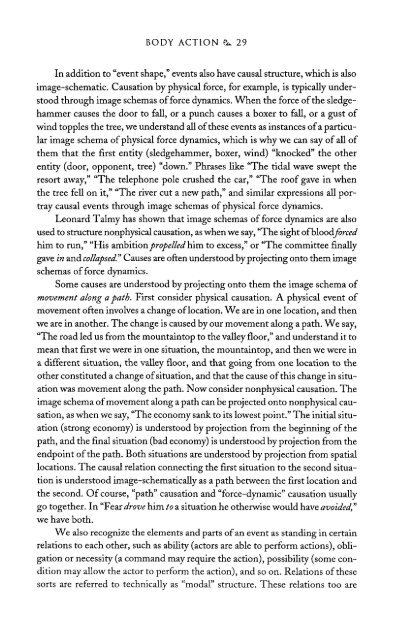The Literary Mind.pdf
The Literary Mind.pdf
The Literary Mind.pdf
Create successful ePaper yourself
Turn your PDF publications into a flip-book with our unique Google optimized e-Paper software.
BODY ACTION 29<br />
In addition to "event shape," events also have causal structure, which is also<br />
image-schematic. Causation by physical force, for example, is typically understood<br />
through image schemas of force dynamics. When the force of the sledgehammer<br />
causes the door to fall, or a punch causes a boxer to fall, or a gust of<br />
wind topples the tree, we understand all of these events as instances of a particular<br />
image schema of physical force dynamics, which is why we can say of all of<br />
them that the first entity (sledgehammer, boxer, wind) "knocked" the other<br />
entity (door, opponent, tree) "down." Phrases like "<strong>The</strong> tidal wave swept the<br />
resort away," "<strong>The</strong> telephone pole crushed the car," "<strong>The</strong> roof gave in when<br />
the tree fell on it," "<strong>The</strong> river cut a new path," and similar expressions all portray<br />
causal events through image schemas of physical force dynamics.<br />
Leonard Talmy has shown that image schemas of force dynamics are also<br />
used to structure nonphysical causation, as when we say, "<strong>The</strong> sight of blood forced<br />
him to run," "His ambition propelled him to excess," or "<strong>The</strong> committee finally<br />
gave in and collapsed." Causes are often understood by projecting onto them image<br />
schemas of force dynamics.<br />
Some causes are understood by projecting onto them the image schema of<br />
movement along a path. First consider physical causation. A physical event of<br />
movement often involves a change of location. We are in one location, and then<br />
we are in another. <strong>The</strong> change is caused by our movement along a path. We say,<br />
"<strong>The</strong> road led us from the mountaintop to the valley floor," and understand it to<br />
mean that first we were in one situation, the mountaintop, and then we were in<br />
a different situation, the valley floor, and that going from one location to the<br />
other constituted a change of situation, and that the cause of this change in situation<br />
was movement along the path. Now consider nonphysical causation. <strong>The</strong><br />
image schema of movement along a path can be projected onto nonphysical causation,<br />
as when we say, "<strong>The</strong> economy sank to its lowest point." <strong>The</strong> initial situation<br />
(strong economy) is understood by projection from the beginning of the<br />
path, and the final situation (bad economy) is understood by projection from the<br />
endpoint of the path. Both situations are understood by projection from spatial<br />
locations. <strong>The</strong> causal relation connecting the first situation to the second situation<br />
is understood image-schematically as a path between the first location and<br />
the second. Of course, "path" causation and "force-dynamic" causation usually<br />
go together. In "Fear drove him to a situation he otherwise would have avoided,"<br />
we have both.<br />
We also recognize the elements and parts of an event as standing in certain<br />
relations to each other, such as ability (actors are able to perform actions), obligation<br />
or necessity (a command may require the action), possibility (some condition<br />
may allow the actor to perform the action), and so on. Relations of these<br />
sorts are referred to technically as "modal" structure. <strong>The</strong>se relations too are















